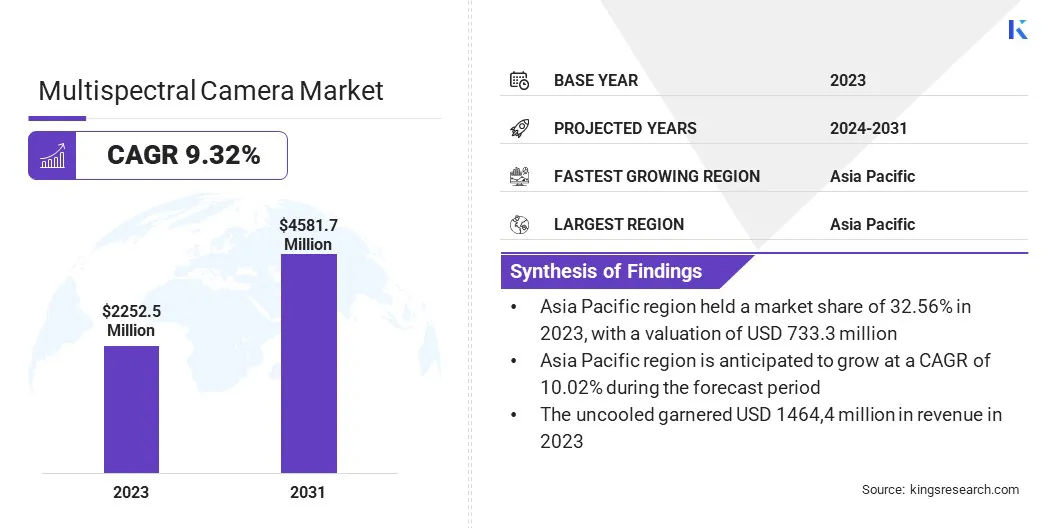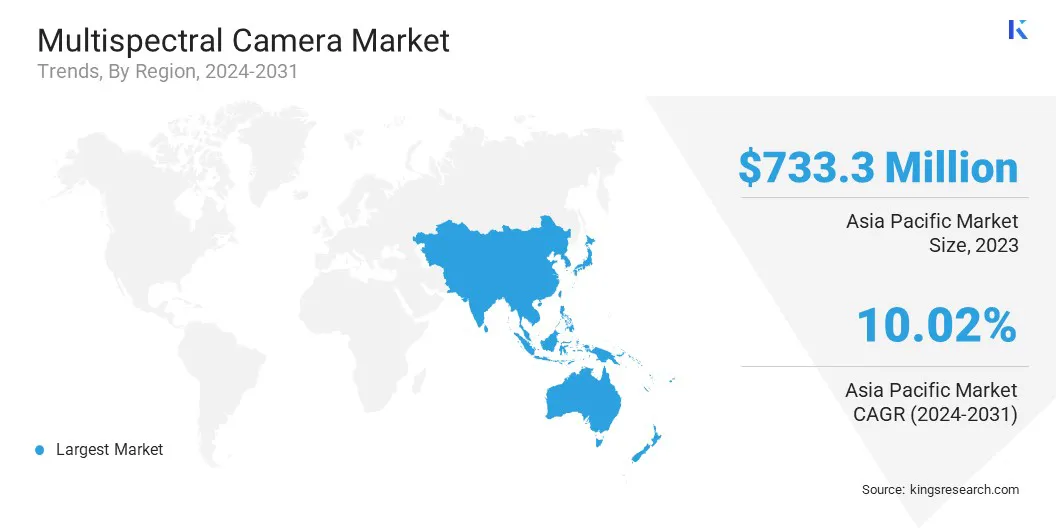Market Definition
The market comprises providers of advanced imaging solutions that capture data across multiple spectral bands. With industries increasingly relying on high-precision imaging for real-time monitoring and data analytics, the market delivers significant value and innovation, solidifying multispectral cameras as essential tools in modern imaging applications.
Multispectral Camera Market Overview
The global multispectral camera market size was valued at USD 2252.5 million in 2023 and is projected to grow from USD 2454.8 million in 2024 to USD 4581.7 million by 2031, exhibiting a CAGR of 9.32% during the forecast period.
The growth is driven by increased demand across agriculture, defense, industrial inspection, and surveillance sectors. Technological advancements, including AI integration and drone-based imaging, are enhancing performance and broadening application areas.
Major companies operating in the multispectral camera industry are Photon Mission B.V, SILIOS Technologies, Teledyne FLIR LLC, Wingtra AG, Spectral Devices, L3Harris Technologies, Inc., Tetracam Inc., JAI, HGH, Satellogic, Leonardo DRS, DJI, Exosens, Collins Aerospace, and Hensoldt AG.
The market is set to deliver significant value and innovation as industries increasingly rely on high-precision imaging solutions for real-time monitoring and data analytics, reinforcing multispectral cameras as essential tools in modern imaging applications.
- In January 2025, Spectricity launched an AI-powered skin analysis solution integrating multispectral imaging (MSI) with Lululab’s AI algorithms. This innovation enables real-time, personalized skincare recommendations via mobile devices, enhancing user convenience and transforming digital skincare diagnostics.

Key Highlights:
- The multispectral camera industry size was valued at USD 2252.5 million in 2023.
- The market is projected to grow at a CAGR of 9.32% from 2024 to 2031.
- Asia Pacific held a market share of 32.56% in 2023, with a valuation of USD 733.3 million.
- The filter based segment garnered USD 1372.4 million in revenue in 2023.
- The uncooled segment is expected to reach USD 3018.9 million by 2031.
- The visible near infrared (VNIR) segment is expected to reach USD 1995.8 million by 2031.
- The commercial segment is expected to reach USD 1602.7 million by 2031.
- The land segment is expected to reach USD 2377.4 million by 2031.
- The market in North America is anticipated to grow at a CAGR of 9.58% during the forecast period.
Market Driver
Enhanced Urban Surveillance and Infrastructure Monitoring
The multispectral camera market is registering significant growth, due to its increasing adoption in urban surveillance and infrastructure monitoring. These advanced imaging systems provide real-time data on structural integrity, environmental changes, and security threats by capturing images across multiple spectral bands.
Municipalities and law enforcement agencies are integrating multispectral cameras into surveillance networks to enhance public safety, detect concealed objects, and monitor high-risk zones such as bridges, tunnels, and historical landmarks.
The demand for high-precision imaging solutions is accelerating as urban areas continue to modernize, positioning the market for sustained growth in surveillance and infrastructure management applications.
- In January 2025, constellr GmbH launched Sky-Bee-1, its first satellite, pioneering thermal infrared technology for precise global land surface temperature monitoring. Equipped with multispectral payloads, it enhances climate analysis, agriculture, and infrastructure management, delivering high-resolution thermal data to public and private sector clients from its sun-synchronous orbit.
Market Challenge
High Initial Costs
A major challenge in the multispectral camera market is the high initial investment required for acquiring and integrating these advanced imaging systems. Many potential users, particularly Small and Medium-sized Enterprises (SMEs) and agricultural businesses, find the upfront costs prohibitive.
Manufacturers should focus on cost reduction through economies of scale and improved manufacturing efficiencies. Developing affordable, user-friendly multispectral cameras with AI-powered analytics can significantly reduce the need for extensive technical expertise.
Additionally, subscription-based pricing models, leasing options, or as-a-service solutions can lower entry barriers, making the technology more accessible to a broader range of industries.
Market Trend
Growing Integration with Artificial Intelligence (AI)
A significant trend in the multispectral camera market is the rapid integration of AI to enhance image analysis, automate data interpretation, and improve decision-making. Traditional multispectral imaging required extensive manual processing and expertise to extract meaningful insights.
However, AI-driven algorithms are revolutionizing this process by enabling real-time image classification, anomaly detection, and predictive analytics across various industries.
As AI models become more sophisticated, their synergy with multispectral imaging will continue to drive efficiency, reduce operational costs, and unlock new applications, solidifying AI as a core driver of the market evolution.
- In September 2024, Teledyne FLIR LLC launched the TrafiBot Dual AI, an advanced multispectral camera system for interurban traffic intelligence. Featuring AI-driven detection and early fire alerts, it enhances safety in tunnels and on bridges, ensuring high-performance traffic monitoring without data loss or imaging resolution compromise.
Multispectral Camera Market Report Snapshot
|
Segmentation
|
Details
|
|
By Technology
|
Filter based, Filter free
|
|
By Cooling Technology
|
Cooled, Uncooled
|
|
By Spectrum Range
|
Near Infrared (NIR), Shortwave Infrared (SWIR), Visible Near Infrared (VNIR), Full-Spectrum Multispectral
|
|
By Application
|
Defense (Intelligence, Surveillance, and Reconnaissance, Target and Tracking, Imaging System), Commercial, Survey And Mapping, Environmental Monitoring, Satellite Remote Sensing, Life Sciences & Medical Diagnostics, Others
|
|
By Portability
|
Man portable, Payload
|
|
By Platform
|
Land, Air, Marine
|
|
By Region
|
North America: U.S., Canada, Mexico
|
|
Europe: France, UK, Spain, Germany, Italy, Russia, Rest of Europe
|
|
Asia-Pacific: China, Japan, India, Australia, ASEAN, South Korea, Rest of Asia-Pacific
|
|
Middle East & Africa: Turkey, UAE, Saudi Arabia, South Africa, Rest of Middle East & Africa
|
|
South America: Brazil, Argentina, Rest of South America
|
Market Segmentation:
- By Technology (Filter based, Filter free): The filter based segment earned USD 1372.4 million in 2023, due to its widespread adoption in precision imaging applications, including agriculture, remote sensing, and industrial inspection.
- By Cooling Technology (Cooled, Uncooled): The uncooled segment held 65.01% share of the market in 2023, due to its cost efficiency, compact design, and reduced power consumption.
- By Spectrum Range (Near Infrared (NIR), Shortwave Infrared (SWIR), Visible Near Infrared (VNIR), and Full-Spectrum Multispectral): The visible near infrared (VNIR) segment is projected to reach USD 1995.8 million by 2031, owing to the growing demand for high-resolution imaging in precision agriculture, surveillance, and remote sensing.
- By Application (Defense, Commercial, Survey and Mapping, Environmental Monitoring, Satellite Remote Sensing, Life Sciences & Medical Diagnostics, and Others): The commercial segment is projected to reach USD 1602.7 million by 2031, owing to the increased use of multispectral cameras in industrial inspection, smart infrastructure monitoring, and security applications.
- By Portability (Man portable, Payload): The payload segment held 70.21% share of the market in 2023, due to the growing use of drone-mounted multispectral cameras in agriculture, defense, and environmental monitoring.
- By Platform (Land, Air, Marine): The land based segment earned USD 1155.1 million in 2023, due to expanding applications in infrastructure monitoring, border surveillance, and autonomous vehicle navigation.
Multispectral Camera Market Regional Analysis
Based on region, the global market has been classified into North America, Europe, Asia Pacific, Middle East & Africa, and Latin America.

Asia Pacific accounted for 32.56% share of the multispectral camera market in 2023, with a valuation of USD 733.3 million. The dominance is driven by the increasing demand from agriculture, defense, and industrial inspection sectors.
Rapid advancements in drone-based imaging, coupled with growing investments in precision agriculture and surveillance, have fueled the adoption of multispectral cameras across key economies such as China, Japan, and India. Additionally, government initiatives supporting smart infrastructure and environmental monitoring have further strengthened the market growth.
As technological advancements continue to improve cost-efficiency and imaging precision, Asia Pacific is expected to maintain its leadership in the market, driven by expanding industrial applications and rising defense expenditures.
The multispectral camera industry in North America is poised to grow at a significant CAGR of 9.58% over the forecast period, driven by a highly robust technological infrastructure and significant R&D investments.
Increasing adoption in defense, precision agriculture, industrial inspection, and urban surveillance is boosting the demand for advanced imaging solutions. Supportive government initiatives further enhance market expansion by encouraging innovative applications and streamlined operational processes.
- In February 2024, AgEagle Aerial Systems Inc. secured a contract from ADS, Inc. to supply Altum-PT multispectral cameras to the U.S. Department of Defense. This highlights the growing adoption of advanced imaging solutions for military and surveillance applications, reinforcing North America's leadership in the market.
Regulatory Frameworks
- In the U.S., the Federal Communications Commission (FCC), National Institute of Standards and Technology (NIST), and Department of Defense (DoD) regulate the market by overseeing communication standards, performance benchmarks, and defense applications, ensuring compliance with national security, operational efficiency, and technological advancements across industries.
- In Europe, the European Commission (EC) regulates the market by enforcing CE marking compliance, ensuring that products meet safety, health, and environmental standards.
Competitive Landscape:
Key market players are focusing on technological advancements, strategic partnerships, and market expansion to gain a competitive edge. Leading manufacturers are investing in AI-driven analytics, enhanced spectral sensitivity, and compact, high-performance designs to cater to diverse industry needs, including defense, agriculture, industrial inspection, and environmental monitoring.
Companies are also expanding their global footprint through mergers, acquisitions, and collaborations to strengthen product portfolios and distribution networks. For instance, firms are increasingly integrating multispectral cameras with drones and autonomous systems, driving innovation in remote sensing applications.
Market leaders differentiate themselves through proprietary imaging algorithms, multispectral sensor advancements, and cost-effective solutions. Scalability, customization, and compliance with industry standards will be key factors shaping market dynamics as competition intensifies, positioning innovation as the primary driver of sustained growth.
- In January 2024, Spectricity launched the first multispectral camera integrated into a smartphone, revolutionizing color accuracy in mobile photography. This innovation enables precise color matching by eliminating errors in automatic white balancing, enhancing image quality for applications in photography, retail, and digital content creation.
List of Key Companies in Multispectral Camera Market:
- Photon Mission B.V
- SILIOS Technologies
- Teledyne FLIR LLC
- Wingtra AG
- Spectral Devices
- L3Harris Technologies, Inc.
- Tetracam Inc.
- JAI
- HGH
- Satellogic
- Leonardo DRS
- DJI
- Exosens
- Collins Aerospace
- Hensoldt AG
Recent Developments (New Product Launch)
- In December 2024, e-con Systems launched a multispectral camera module powered by the OV4682 sensor, enhancing imaging capabilities for applications such as precision agriculture, medical diagnostics, and industrial inspection. This advanced module delivers high-resolution multispectral imaging, enabling real-time data analysis for improved decision-making across various industries.


